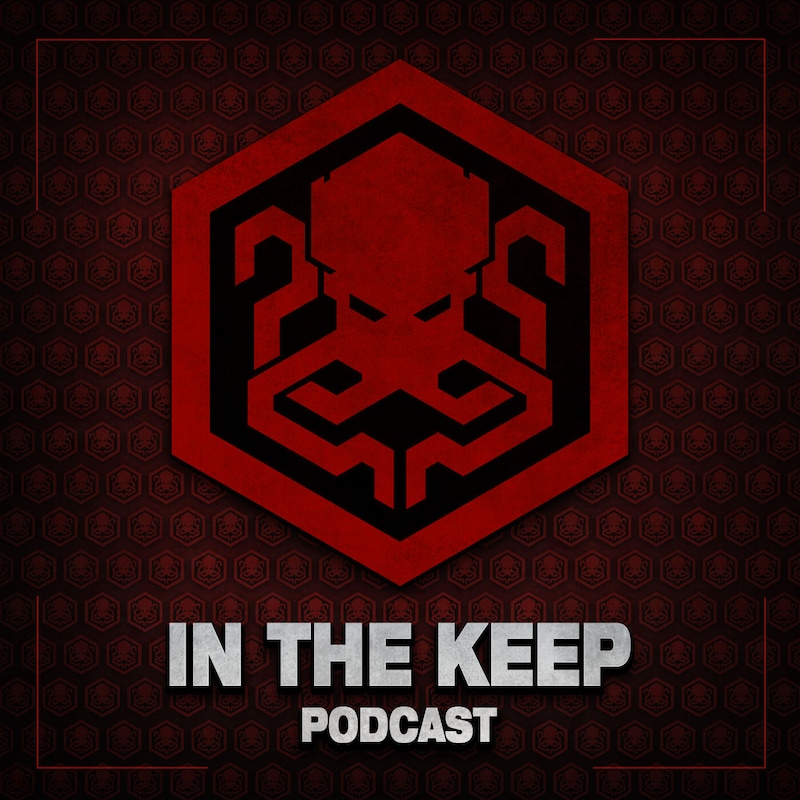bonus
State Of The Keep Address Sep 2023
#133 Bauul (Elementalism)
State of The Keep Address May 2022
#132 Tristan Clark (Elementalism)
#131 Nash Muhandes (GZDoom Developer)
#130 Douwe van den Berg & Ben Reichstein (Wim Hof Method)
#129 Chris Guerrero (Stellar Valkyrie)
#128 Jared Bair (DaBesJared)
#127 Aleks with a K (Alkaline OST)
#126 Vince Steel (In The Keep/Dread XP)
#125 Foamy Returns! (Unleash Hell)
ITK Rewind: #89 MK Schmidt (Star Explorers)
ITK Rewind: #75 Andeh (SuddendeathTV)
ITK Rewind: #35 Bruno Beaudoin (Nightmare Reaper)
ITK Rewind: #07 LocKtar (QuakeWorld Pro)
Call of Saregnar Devlog Nov 2021 w/ Tony Manfredonia
#124 Sonic Psychology: Sound Design Panel
#123 Omar Samir & Christian Kendall (BUFF)
#122 Chris Heist (Comedian)
Call of Saregnar Devlog Oct 2021 w/ Ben Reichstein
#121 Richard Martin (The Bazaar Cast) Simulcast
#120 Dennis Griesheimer (GRAVEN)
State Of The Keep Address Oct 2021
#118 Robert Raulus & Mikko Tamper Return! (White Hell)
#117 Awesreek Returns! (Viscerafest)
#116 kairos (Quake Defrag Mapper)
Realms Deep 2021 | #114 Mike Ewer, Steven Rock & Grant Armstrong (Relentless Frontier)
Realms Deep 2021 | #115 Indie Game Musician’s Panel
Realms Deep 2021 | #111 Jon of the Shred (Happy’s Humble Burger Farm)
Realms Deep 2021 | #113 Foamy (Unleash Hell)
Realms Deep 2021 | #112 Jason Smith (CULTIC)
Road to Realms Deep 2021 | #110 Ivar Hill Returns! (Core Decay)
#109 Orlando Guevara (Grimcurse)
#108 Crimson Reaper (Project Downfall)
#107 Zdravko Marinov Returns! (Limitless Hunger)
Road to Realms Deep 2021 | #106 Robin Block & David L. Craddock (FPS: First Person Shooter Documentary)
#105 Sam Prebble (Turbo Overkill)
#104 Scumhead (Vomitoreum)
#103 Rich Vreeland (Disasterpeace)
#101 Smilecythe (Quake Mapper)
#100 Part 3: I Kill Pigeons Returns (Orange Bucket Acting Troupe)
#100 Part 2: Violentheart, Uncle Had, nAeb, RedEyesGreenDragon, Flambeau (In The Keep)
#100 Part 1: State of the Keep Address June 2021
#98 Major Arlene (Technicolor Antichrist Box)
#96 Wojtek Mroczek (HYPERSTRANGE)
#95 Kaapeli47 (Golds of FPS)
#94 Jordan Mochi (CONSCRIPT)
#93 Al (SKALD: Against the Black Priory)
#92 David Szymanski (Dread X Collection: The Hunt)
#91 Vince Desi (Running with Scissors)
TALKING DOOM w/ Flambeau & Animal
#90 Mike Hermann (RetroMania Wrestling)
#89 MK Schmidt (Star Explorers)
#88 Damjan, Tony & Ben (Call of Saregnar)
#87 PapaScho (Modern Retro FPS Games)
#86 Kristus (Doombringer)
#85 Zach Murphy (E1M1 Magazine)
State of The Keep Address Feb 2021
#84 Bridgeburner (The Age of Hell)
#83 Jake The Voice (E1M1 Magazine)
#82 Ivar Hill (Core Decay)
#81 Quicktequila (Lovely Planet)
Burning Bridges w/ Bridgeburner Podcast: #01 New Year’s Eve 2020
#79 Jason Mojica (Prodeus)
#78 Steev (New Blood Interactive)
#77 Em3raldTig3r (Uber Arena)
#76 Johnathan Wendel (Fatal1ty)
#75 Andeh (SuddendeathTV)
#74 Michael Markie (Markie Music)
#73 StarlightSkyes (Dread XP)
#72 Aubrey Hodges (Musical Composer)
bonus
Operation Lovecraft: The Alchemist
#71 Nico & M3ssia (US QuakeWorld)
#70 Jacob Shrader & Roger Caneda (ZenSports)
#69 MK Schmidt (Paradox Vector)
#68 Robert Raulus & Mikko Tamper (White Hell)
#67 Mahelyk (SCP: Blackout)
Jon St. John @ Realms Deep 2020
Cliff Bleszinski @ Realms Deep 2020
Tim Willits @ Realms Deep 2020
John Romero @ Realms Deep 2020
American McGee @ Realms Deep 2020
Chuck Jones @ Realms Deep 2020
#N64 Immorpher (Musician/Biophysicist)
#62 Mike Jaret-Schachter (Running With Scissors)
#61 Awesreek (Viscerafest)
TALKING DOOM w/ Flambeau, RedEyesGreenDragon & AF-Domains
#60 Vince Steel (Game Reviewer)
#59 Théo “Totos” Touaty (Cyber Hook)
#58 Hakita Returns (ULTRAKILL)
#57 James “Quasar” Haley (Nightdive Studios)
#56 Conner Howard & Bruno Beaudoin (The Great Doom Eternal Debate)
bonus
State Of The Keep Address June 2020
#55 Sgt_Mark_IV (Brutal Doom)
bonus
Apostles Gathering May 2020
#54 Nate Berens (Redact Games)
#53 Ted Hentschke (Dread X Collection)
#52 Muleke_Trairao (Game Translator)
#50 Matt Tropiano (The Adventures of Square & Doombringer)
#49 James Paddock (MIDI Artist)
#48 Dillon Rogers (Gloomwood)
#47 Dave Oshry (New Blood Interactive)
#46 Stephen Kick (Nightdive Studios)
#44 BigEyeGuy & no_il (Arena Israel)
bonus
Waiting for DOOM Eternal...
#41 Frederik Schreiber (3D Realms)
#39 Shadesmaster & BloodShot (Slayer’s Testaments)
#37 Dragonfly (Eviternity & Prodeus)
#36 Jeremiah “KillPixel” Fox (Wrath: Aeon of Ruin)
#35 Bruno Beaudoin (Nightmare Reaper)
#34 David Szymanski (Dusk)
#33 MiFU (The Sentinel’s Playground)
bonus
TALKING DOOM w/ Flambeau, AF-Domains & HumanBones
#31 Makaveli (Quake 2/3 Pro)
#30 CrazyAl & GMT (TimConLAN)
bonus
State Of The Keep Address
#29 Kristus (Doombringer)
#28 Kaapeli47 (FPS Historian)
#27 GNiK (Quake Champions Pro)
#26 the_hack (Shock & Rockets)
#25 wadaholic (Total Chaos)
bonus
The Pigeon Classic 2019 Recap Show!
#23 Milton (QuakeWorld Pro)
#22 dumptruck_ds (Quakecast/Quake Mapping Community)
#21 RottenRose (TastySpleen)
#20 LocKtar (QHLAN 2019 Duel Champion)
#19 DevastatioN (Doom 2 Pro)
#18 Shazzik (Beyond Strafe Jumping)
bonus
Doom Is Dead? Podcast - #01 TheMotherload (In The Keep)
#17 Smango (quakefans.net)
#16 Carnevil (Skulltag/Wrack: Exoverse)
#15 Andrew Hulshult (Composer/Sound Designer)
#13 DBThanatos & Michaelis (QC: Doom Edition)
#12 TALKING DOOM w/ Flambeau (ZDaemon) & NationwideMoose (USQC)
#11 Zdravko Marinov (Limitless Hunger Developer)
#09 Albert Adeikalam (Master Arena Developer)
#08 M3ssia (US Quake Community)
#07 LocKtar (QuakeWorld Pro)
#06 I Kill Pigeons (The Keep/Orange Bucket Acting Troupe)
#05 HumanBones (Multiplayer Doom Federation)
#04 Psygib (Quake Champions Pro)
#03 Ceasepool (Duskworld)
#01 Violentheart (Quake 4 Pro)





